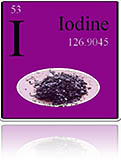Science of Iodine

Iodine is included in the element list of the lesser 1/3 in abundance and is therefore classified as a rare element. It is classified as a non metallic element – showing that it has little of the characteristics of metallic elements. Its appearance however is metallic, dark bluish black in color. It is a solid, not a liquid or gas like the halogens above it in the periodic table. It is however volatile and therefore when heated it sublimes to a purple vapor. It is included in the seventh column of the periodic table, fourth in this halogen column. It has a characteristic odor and a sharp acrid taste. Like the other halogen elements it is diatomic, meaning that in its atomic state there are two atoms bound together to give one entity referred to as I2. Elemental Iodine can easily be reduced chemically or electrochemically to iodide ion by the addition of an electron, and can easily be oxidized chemically or electrochemically, yes by removal of from 1 to 7 electrons. It is quite interesting that both the addition of one electron and the removal of from 1 to 7 electrons eliminate the color of elemental Iodine. This interesting fact is extremely useful and used extensively for a number of analytical procedures for Iodine analysis. It is also interesting to note that Iodine is slightly soluble in water; however the addition of iodide ion increases the solubility in water substantially. Iodine’s atomic diameter is quite large and heavy. Its size and weight and physicochemical parameters significantly affect its chemistry when compared to other halogens and make it a most unique and interesting state of elemental matter to work with and include in the development of useful value added products.
In addition to the inorganic chemistry of elemental Iodine there is another class of quite different and interesting chemistry involving bound or organic Iodine chemistry. Iodine combines with other elements such as carbon to produce what is referred to as organo Iodine compounds or organic iodides.
A partial list of iodine derivatives includes:
- 3.3 Triiodo allylalcohol
- 1,4-Diiododurene
- 2.2 Trifluoro-1-iodo ethane
- 2,3,5 Triiodo sodium benzoate
- 3,5-Diiodosalicyclic acid
- 4,4’-Diiododiphenyl
- Ammonium iodide
- Barium Iodide
- Butyl Iodide
- Cesium Iodide
- Copper Iodide
- Cetyl iodide
- Diacetoamido-triiodobenzoic acid
- Difluordiiodomethane
- Diiodobenzoic Acid
- Diiododiphenyl
- Ethyl iodide
- Ethylene iodide
- Ethylene diamine dihydrooiodide (EDDI)
- Ethyltriphenyl phosphonium iodide
- Hydroiodic acid solution (HI)
- Iodic acid
- Iodic acid (aqueous solution)
- Iodine monocholoride
- Iodine pentafluoride
- Iodo acetic acid
- Iodobenzene
- Iodoxybenzene
- Iodoform
- IPBC
- Iodine disinfectant
- Iodine Tincture
- Iron Iodide
- Isobutyl Iodide
- Isopropyl iodide
- Isoquinoline butyliodide
- Lithium iodide
- o-Iodotoluene
- p-Iodotoluene
- m-Iodotoluene
- Methyl iodide
- Methylene iodide
- Methyltributyl phosphonium iodide
- n-Butyl iodide
- n-Hexyl iodide
- n-Octyl iodide
- n-Propyl iodide
- o-Iodotoluene
- o-Iodonitrobenzene
- o-Iodobenzoic acid
- p-Iodobenzoic acid
- p-Iodotoluene
- Potassium Iodide
- p-Tolydiiodo methyl sulfonium
- Silver iodide
- Sodium iodate
- Sodium iodide
- Tetramethyl oxosulfonium iodide
- Tetraethyl ammonium iodide
- Tetramethyl ammonium iodide
- Tetrabutyl ammonium iodide
- Thymol iodide
- Titanium iodide
- Tin iodide
- Triiodobenzoic acid
- Triiodo pheno
8480 East Orchard Road, Suite 4900
Greenwood Village, Colorado 80111
+1 303-222-1215
+1 303-222-1201 fax



